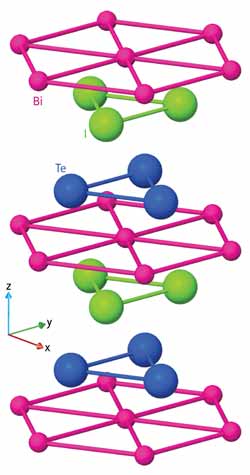Splitting spin to get ahead

Figure 1: The layered atomic structure of BiTeI creates a three-dimensional version of the Rashba effect, normally seen at only two-dimensional surfaces and interfaces (pink, bismuth; blue, tellurium; iodine, green). Copyright : Reproduced from Ref. 1 © 2011 K. Ishizaka et al. <br>
In the developing field of spintronics, physicists are designing devices to transmit data using the inherent axial rotation, or spin, of electrons rather than their charge as is used in electronics.
Weak coupling of electron spin to electrical currents, however, makes gaining this level of control difficult. Yoshinori Tokura from the RIKEN Advanced Science Institute, Wako, working with colleagues from across Japan, has now shown that the semiconducting material BiTeI could provide the control needed because of its unusual atomic arrangement1.
Spin can take one of two values, conventionally labeled ‘up’ and ‘down’. Usually, an electron in a state with an up-spin has the same energy as an electron in the equivalent down-spin state. This so-called ‘energy degeneracy’ makes it difficult to control up and down spins independently. “A principle technique in spintronics is to manipulate spin by means of an electric current or voltage,” says University of Tokyo scientist and co-author of the paper Kyoko Ishizaka. “Lifting this degeneracy will enable a number of novel spin-to-current conversion techniques.”
One way to split the energy of the two spin states is to destroy the symmetry of the atomic lattice; at a surface or at the interface between two materials for example. This is known as the Rashba effect. Physicists have observed this effect; however, splitting energy in these two-dimensional (2D) systems was, in general, too small for real applications. Tokura, Ishizaka and their team demonstrated experimentally a Rashba-type effect in three-dimensional, or ‘bulk’, BiTeI. “In 2D Rashba systems, spintronic function is hindered by the electrons away from the surface, which remain degenerate,” explains Ishizaka. “In BiTeI, on the other hand, all the carrier electrons are spin-split.”
The researchers studied BiTeI using a technique called angle-resolved photoemission spectroscopy, whereby electrons excited from the surface of a sample by incoming light provided details about the material’s energy structure. The measurements showed that the spin splitting was large enough to make BiTeI a potential material for various spin-dependent electronic functions. The researchers took a first-principles approach to modeling their material system to obtain a better understanding of the origin of this effect. They showed that the large amount of spin-splitting was a result of the layered atomic structure of BiTeI (Fig. 1) in which the bismuth, tellurium and iodine atoms arranged into separate tiers, each with a triangular lattice.
“Next we will study the spin-dependent transport and optical properties of BiTeI, with the aim of making a functional device,” says Ishizaka.
The corresponding author for this highlight is based at the Cross-Correlated Materials Research Group, RIKEN Advanced Science Institute
Ishizaka, K., Bahramy, M.S., Murakawa, H., Sakano, M., Shimojima, T., Sonobe, T., Koizumi, K., Shin, S., Miyahara, H., Kimura, A. et al. Giant Rashba-type spin splitting in bulk BiTeI. Nature Materials 10, 521–526 (2011)
Media Contact
All latest news from the category: Materials Sciences
Materials management deals with the research, development, manufacturing and processing of raw and industrial materials. Key aspects here are biological and medical issues, which play an increasingly important role in this field.
innovations-report offers in-depth articles related to the development and application of materials and the structure and properties of new materials.
Newest articles

Superradiant atoms could push the boundaries of how precisely time can be measured
Superradiant atoms can help us measure time more precisely than ever. In a new study, researchers from the University of Copenhagen present a new method for measuring the time interval,…

Ion thermoelectric conversion devices for near room temperature
The electrode sheet of the thermoelectric device consists of ionic hydrogel, which is sandwiched between the electrodes to form, and the Prussian blue on the electrode undergoes a redox reaction…

Zap Energy achieves 37-million-degree temperatures in a compact device
New publication reports record electron temperatures for a small-scale, sheared-flow-stabilized Z-pinch fusion device. In the nine decades since humans first produced fusion reactions, only a few fusion technologies have demonstrated…





















